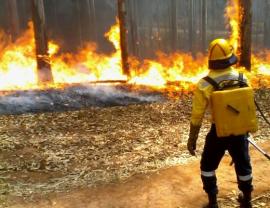
In an attempt to be proactive in managing uncontrolled fires, the Department of Forestry, Fisheries and the Environment (DFFE) has to date registered 217 Fire Protection Associations (FPAs).
“The department is empowered by the National Veld and Forest Fires Act, 1998 (NVFFA) to prevent and combat veld, forest and mountain fires throughout the Republic, and provides for a variety of institutions, methods and practices for achieving this purpose,” the Deputy Minister of Forestry, Fisheries and the Environment, Bernice Swarts, said on Monday.
Addressing the closing of the 2024 Arbor Month Campaign, Swarts said one of the biggest threats to natural vegetation, property and valuable life is uncontrolled veld and forest fires.
“Some areas in the country are rated as extremely high veld risk areas due to the fact that more than 90% of the area is covered with woodlands. Every year, many lives are lost and millions of rands worth of damages are caused to property, livestock, the environment and the livelihoods, especially that of the rural poor,” Swarts said.
The department is in a process of aligning the FPAs to municipal boundaries to ensure effective use of resources and increased participation and inclusivity, especially for previously disadvantaged communities.
“To ensure that the FPAs are functional, the DFFE provides financial support to FPAs through the Working on Fire Programme and is in the process of transferring vehicles to district municipalities for use by FPAs.
“This will be done in phases, noting that that there are certain requirements that must be met by the FPAs for benefiting from this support. We are aware of other challenges and the department will work closely with Umbrella FPAs to ensure that such challenges are addressed,” the Deputy Minister said.
The responsibilities of FPAs include developing and applying a veld fire management strategy for an area, identifying natural conditions that can cause fire, and regularly communicating fire danger ratings to members in a designated area.
Forestry Sector Masterplan
Meanwhile, government has developed the Forestry Sector Masterplan as a growth, transformation and investment plan for the sector, which is a collaborative effort of government.
One of the key deliverables of the masterplan is the New Afforestation Programme, which refers to the establishment of new plantations on virgin land (undisturbed soil).
“For one to establish plantations, a licence is required in terms of the provisions of the National Water Act, 1998, National Environmental Management Act, 1998 and the Conservation of Agricultural Resources Act, 1983. The process involves satisfying the issues of water availability, undertaking costly Environmental Impact Assessment (EIA) studies and issues related to soil conservation.
“The DFFE, through the then Department of Water Affairs and Forestry, undertook a study to assess the potential for afforestation in the country, except in the Western Cape. The results reflected an opportunity of 100 000 hectares in the Eastern Cape and 39 000 hectares in KwaZulu-Natal,” Swarts said.
The department has been playing a role of streamlining the afforestation licensing process by paying for the costly EIA studies on behalf of communities.
“This ensures that delays in afforestation are reduced, and communities are supported in obtaining licences. Currently, the period for issuing licences from the Department of Water and Sanitation (DWS) is 90 days.
“The department has about 44 000 hectares worth of licences in the pipeline, which are due for EIAs. The department is in the process of finalising the appointment of Environmental Assessment Practitioners (EAPs) to conduct the studies,” Swarts said.
The masterplan had set a minimum investment target of R16.5 billion, with a maximum target of R30 billion for the year 2025/26.
“Currently, the Rand value of private sector investment has reached R33.2 billion, clearly indicating that the sector has well exceeded the R30 billion target set for the 2025/26 financial year.
“Ensuring that the plantations under the management of the department are brought back into production is high on the agenda of the masterplan. Currently, about 6213,58 hectares have been transferred to communities through the Community Forestry Agreement Model, in line with Section 29 of the National Forests Act, 1998.
“This translates to 27 plantations transferred to communities through the signing of 23 Community Forestry Agreements. Plans are in place to continue with this process, including the leasing of the remaining plantations in the Western Cape.
“As these transfers take place, it is important for the industry to work closely with the department in ensuring that post settlement support is provided for these communities so that they can thrive in the sector,” the Deputy Minister said. - SAnews.gov.za


